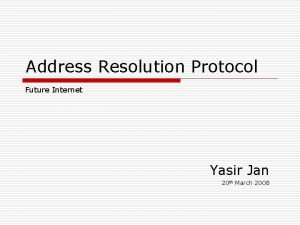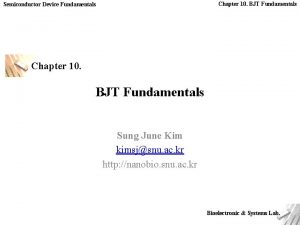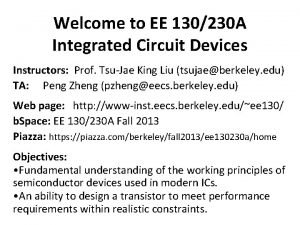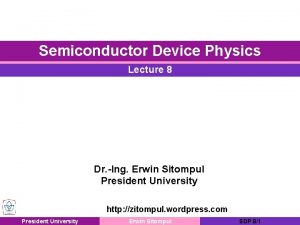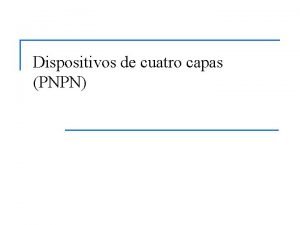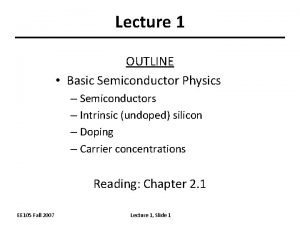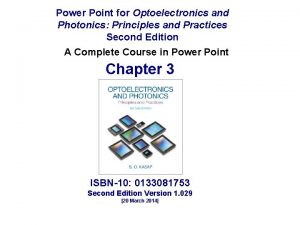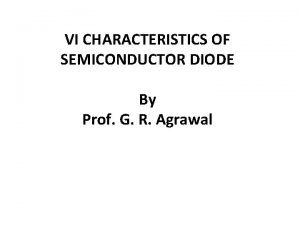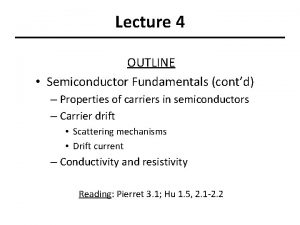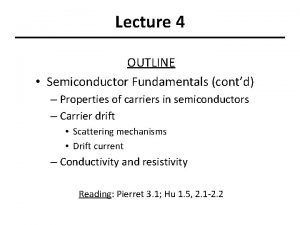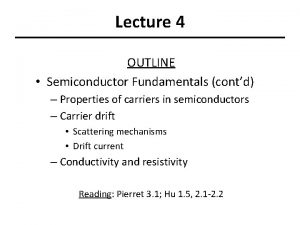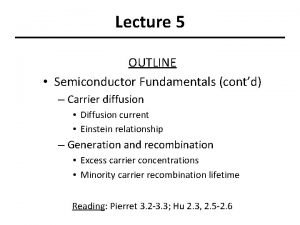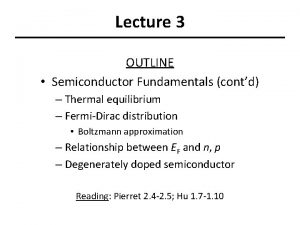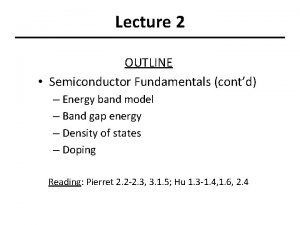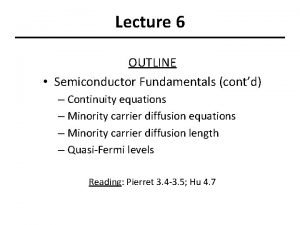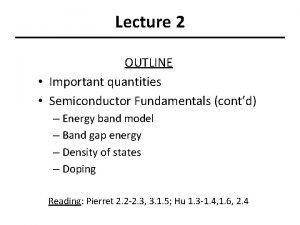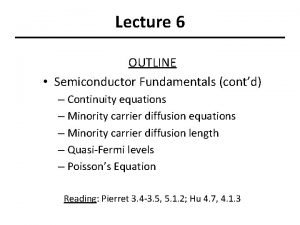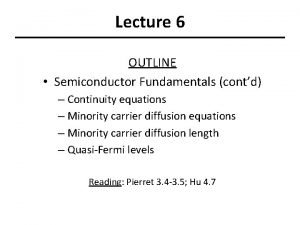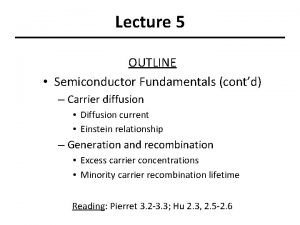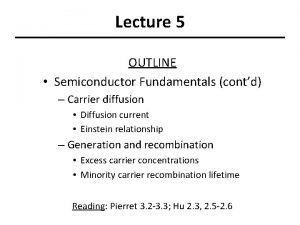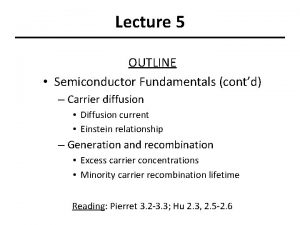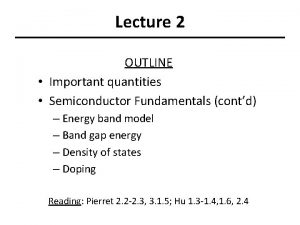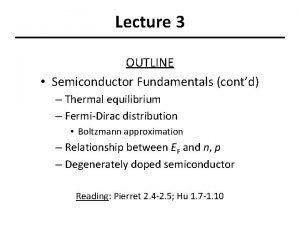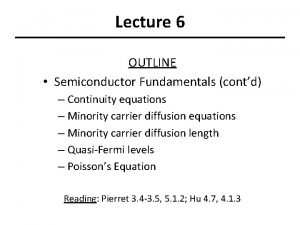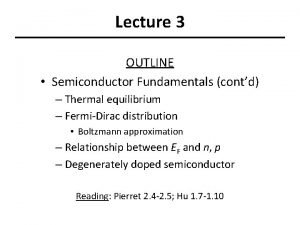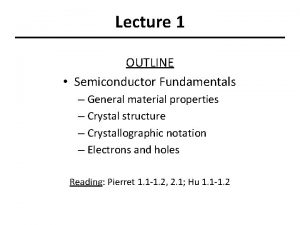Lecture 4 OUTLINE Semiconductor Fundamentals contd Properties of

























- Slides: 25

Lecture 4 OUTLINE • Semiconductor Fundamentals (cont’d) – Properties of carriers in semiconductors – Carrier drift • Scattering mechanisms • Drift current – Conductivity and resistivity Reading: Pierret 3. 1; Hu 1. 5, 2. 1 -2. 2

Mobile Charge Carriers in Semiconductors • Three primary types of carrier action occur inside a semiconductor: – Drift: charged particle motion under the influence of an electric field. – Diffusion: particle motion due to concentration gradient or temperature gradient. – Recombination-generation (R-G) EE 130/230 M Spring 2013 Lecture 4, Slide 2

Electrons as Moving Particles In vacuum In semiconductor F = (-q)E = moa F = (-q)E = mn*a where mn* is the conductivity effective mass EE 130/230 M Spring 2013 Lecture 4, Slide 3

Conductivity Effective Mass, m* Under the influence of an electric field (E-field), an electron or a hole is accelerated: electrons holes Electron and hole conductivity effective masses Si Ge Ga. As mn*/mo 0. 26 0. 12 0. 068 mp*/mo 0. 39 0. 30 0. 50 mo = 9. 1 10 -31 kg EE 130/230 M Spring 2013 Lecture 4, Slide 4

Carrier Scattering • Mobile electrons and atoms in the Si lattice are always in random thermal motion. – Electrons make frequent collisions with the vibrating atoms “lattice scattering” or “phonon scattering” – increases with increasing T • Other scattering mechanisms: – deflection by ionized impurity atoms – deflection due to Coulombic force between carriers “carrier-carrier scattering” – only significant at high carrier concentrations • The net current in any direction is zero, if no E-field is applied. 2 3 4 EE 130/230 M Spring 2013 Lecture 4, Slide 5 1 electron 5

Thermal Velocity, vth Average electron kinetic energy EE 130/230 M Spring 2013 Lecture 4, Slide 6

Carrier Drift • When an electric field (e. g. due to an externally applied voltage) exists within a semiconductor, mobile charge-carriers will be accelerated by the electrostatic force: 2 3 5 1 electron 4 E Electrons drift in the direction opposite to the E-field net current Because of scattering, electrons in a semiconductor do not undergo constant acceleration. However, they can be viewed as quasiclassical particles moving at a constant average drift velocity vdn EE 130/230 M Spring 2013 Lecture 4, Slide 7

Carrier Drift (Band Model) Ec Ev EE 130/230 M Spring 2013 Lecture 4, Slide 8

Electron Momentum • With every collision, the electron loses momentum • Between collisions, the electron gains momentum –q. E mn tmn ≡ average time between electron scattering events Conservation of momentum |mn*vdn | = | q. E mn| EE 130/230 M Spring 2013 Lecture 4, Slide 9

Carrier Mobility, m For electrons: |vdn| = q. E mn / mn* ≡ mn. E n [q mn / mn*] is the electron mobility Similarly, for holes: |vdp|= q. E mp / mp* p. E p [q mp / mp*] is the hole mobility Electron and hole mobilities for intrinsic semiconductors @ 300 K mn (cm 2/V s) mp (cm 2/V s) EE 130/230 M Spring 2013 Si 1400 470 Ge 3900 1900 Lecture 4, Slide 10 Ga. As 8500 400 In. As 30, 000 500

Example: Drift Velocity Calculation a) Find the hole drift velocity in an intrinsic Si sample for E = 103 V/cm. b) What is the average hole scattering time? Solution: a) vdp = p. E b) EE 130/230 M Spring 2013 Lecture 4, Slide 11

Mean Free Path • Average distance traveled between collisions EE 130/230 M Spring 2013 Lecture 4, Slide 12

Mechanisms of Carrier Scattering Dominant scattering mechanisms: 1. Phonon scattering (lattice scattering) 2. Impurity (dopant) ion scattering Phonon scattering limited mobility decreases with increasing T: = q / m EE 130/230 M Spring 2013 Lecture 4, Slide 13

Impurity Ion Scattering There is less change in the electron’s direction if the electron travels by the ion at a higher speed. Ion scattering limited mobility increases with increasing T: EE 130/230 M Spring 2013 Lecture 4, Slide 14

Matthiessen's Rule • The probability that a carrier will be scattered by mechanism i within a time period dt is i ≡ mean time between scattering events due to mechanism i Probability that a carrier will be scattered by any mechanism within a time period dt is EE 130/230 M Spring 2013 Lecture 4, Slide 15

Mobility Dependence on Doping Carrier mobilities in Si at 300 K EE 130/230 M Spring 2013 Lecture 4, Slide 16

Mobility Dependence on Temperature EE 130/230 M Spring 2013 Lecture 4, Slide 17

Hole Drift Current Density, Jp, drift vdp Dt A = volume from which all holes cross plane in time Dt p vdp Dt A = number of holes crossing plane in time Dt q p vdp Dt A = hole charge crossing plane in time Dt q p vdp A = hole charge crossing plane per unit time = hole current Hole drift current per unit area Jp, drift = q p vdp EE 130/230 M Spring 2013 Lecture 4, Slide 18

Conductivity and Resistivity • In a semiconductor, both electrons and holes conduct current: • The conductivity of a semiconductor is – Unit: mho/cm • The resistivity of a semiconductor is – Unit: ohm-cm EE 130/230 M Spring 2013 Lecture 4, Slide 19

Resistivity Dependence on Doping For n-type material: For p-type material: p-type n-type EE 130/230 M Spring 2013 Note: This plot (for Si) does not apply to compensated material (doped with both acceptors and donors). Lecture 4, Slide 20

Electrical Resistance I + V _ W t uniformly doped semiconductor L Resistance [Unit: ohms] where is the resistivity EE 130/230 M Spring 2013 Lecture 4, Slide 21

Example: Resistance Calculation What is the resistivity of a Si sample doped with 1016/cm 3 Boron? Answer: EE 130/230 M Spring 2013 Lecture 4, Slide 22

Example: Dopant Compensation Consider the same Si sample doped with 1016/cm 3 Boron, and additionally doped with 1017/cm 3 Arsenic. What is its resistivity? Answer: EE 130/230 M Spring 2013 Lecture 4, Slide 23

Example: T Dependence of r Consider a Si sample doped with 1017 cm-3 As. How will its resistivity change when the temperature is increased from T=300 K to T=400 K? Answer: The temperature dependent factor in (and therefore ) is n. From the mobility vs. temperature curve for 1017 cm-3, we find that n decreases from 770 at 300 K to 400 at 400 K. Thus, increases by EE 130/230 M Spring 2013 Lecture 4, Slide 24

Summary • Electrons and holes can be considered as quasi-classical particles with effective mass m* • In the presence of an electric field E, carriers move with average drift velocity vd = m. E , m is the carrier mobility – Mobility decreases w/ increasing total concentration of ionized dopants – Mobility is dependent on temperature • decreases w/ increasing T if lattice scattering is dominant • decreases w/ decreasing T if impurity scattering is dominant • The conductivity ( ) hence the resistivity ( ) of a semiconductor is dependent on its mobile charge carrier concentrations and mobilities EE 130/230 M Spring 2013 Lecture 4, Slide 25
 Parceloo
Parceloo Fundamentals of semiconductor devices
Fundamentals of semiconductor devices Zerobioelectronic
Zerobioelectronic Advanced semiconductor fundamentals
Advanced semiconductor fundamentals Advanced semiconductor fundamentals
Advanced semiconductor fundamentals Semiconductor device fundamentals
Semiconductor device fundamentals Semiconductor device fundamentals
Semiconductor device fundamentals Diac de cuatro capas
Diac de cuatro capas Basic semiconductor physics:
Basic semiconductor physics: Power semiconductor devices lecture notes
Power semiconductor devices lecture notes 01:640:244 lecture notes - lecture 15: plat, idah, farad
01:640:244 lecture notes - lecture 15: plat, idah, farad Energy band diagram of n type semiconductor
Energy band diagram of n type semiconductor Lecture outline example
Lecture outline example Lecture outline example
Lecture outline example Lecture outline example
Lecture outline example Lecture outline meaning
Lecture outline meaning Examples of quote sandwiches
Examples of quote sandwiches Lesson outline physical properties lesson 2
Lesson outline physical properties lesson 2 Wave properties lesson 2
Wave properties lesson 2 Extensive vs intensive properties
Extensive vs intensive properties Chemical property of matter
Chemical property of matter Difference between pn junction diode and zener diode
Difference between pn junction diode and zener diode Semiconductor ram memories
Semiconductor ram memories Semiconductor tipo p
Semiconductor tipo p Power semiconductor devices
Power semiconductor devices Long waves and short waves
Long waves and short waves
